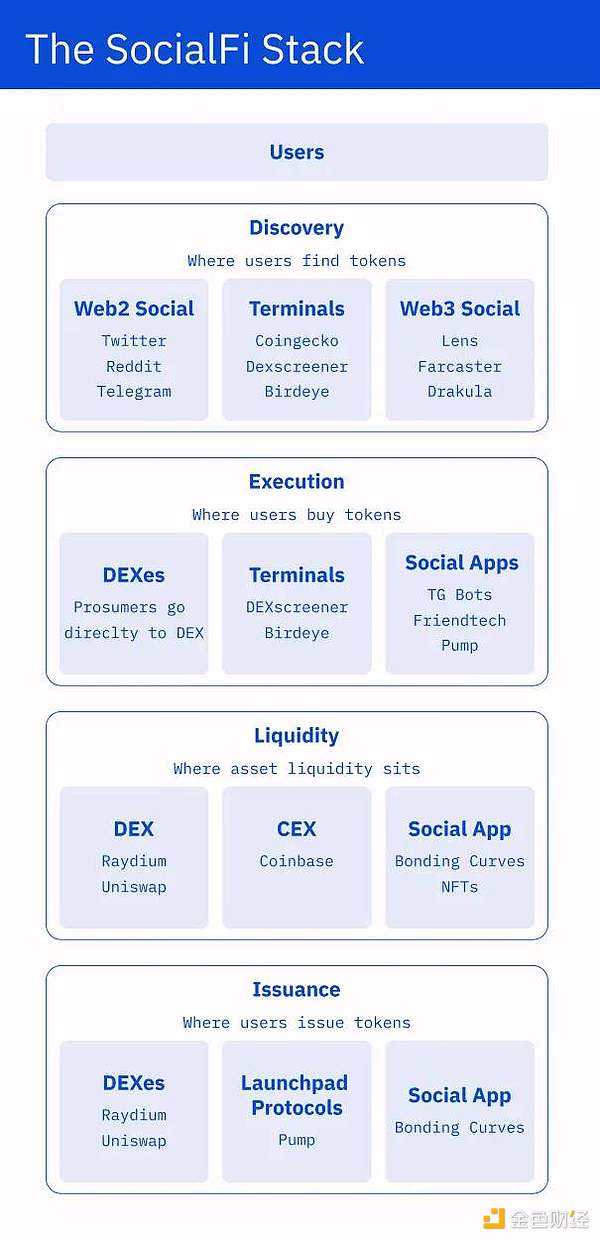Author: MASON NYSTROM
Compiler: TechFlow
As the use of crypto social platforms and financial games increases, the way they are built is also evolving. We can expect to see more projects tend to be verticalized in the future, aiming to provide users with a more seamless and comprehensive experience, thereby giving rise to new consumer behaviors and attention-based assets or social assets. While not all web3 social experiences are related to finance, the blockchain infrastructure that supports these crypto consumer applications can integrate new token incentive behaviors and digital native assets into social experiences.
The existing SocialFi stack consists of four core layers:
Discovery Layer - where users discover items they want to buy
Execution Layer - where assets are bought and sold
Liquidity Layer - where assets are stored and aggregated
Asset Issuance Layer - where assets are created
Currently, the stack is fragmented, with user discovery and social experience disconnected from execution (such as trading), liquidity, and asset issuance. But as the SocialFi space expands, various applications will continue to work on verticalized attention and marketplaces to better control the user's social experience and the liquidity of attention assets.
SocialFi application developers need to own multiple layers of the SocialFi stack to build defensibility of the protocol. Attention asset trading (i.e. execution) and issuance are the commoditized layers of the stack - token issuance is getting easier and execution can be added to anywhere attention is owned. Owning a discovery or liquidity layer will become increasingly important as these are defensible layers with strong network effects.

In SocialFi, most applications choose between two verticalization approaches:
Transaction First Approach: Build a trading platform or marketplace where users can trade attention assets (such as Memes) first, and then evolve into a social/discovery platform.
Social/Discovery First Approach: Build a social platform first, then gradually add financial elements. Make consumers/attention merchants key stakeholders in the platform.
Transaction First
Any social network or discovery platform faces huge challenges in today’s competitive attention market: bootstrapping new social networks, inspiring new consumer behaviors, and keeping users engaged. Given these obstacles, a transaction-first approach is often easier to launch, as users’ appetite for speculation helps overcome these challenges. However, this approach faces more competition, as transaction platforms are easier to launch than social networks, and social networks retain many of their advantages once they reach a certain user density.
From a transaction-first approach, the deep verticalization of the SocialFi stack has proven effective, as these apps have built-in attention trading capabilities. For example, Friendtech has become one of the most vertically integrated SocialFi apps, able to control the entire stack. Not only is the app a hub for user discovery and exclusive trading, it also leverages a native financial fundamental called a “bonding curve” to issue assets with features specific to the Friendtech app.
Some of the newer SocialFi protocols have also achieved vertical integration of the stack. For example, meme issuance and discovery platforms like Pump and Ape Store allow users to easily deploy memes on bonding curves. This allows users to purchase tokens directly from the bonding curve without waiting for someone to inject liquidity into a decentralized exchange or liquidity pool. While some Pump-initialized meme trading and discovery can be conducted on other platforms such as Dexscreener and Twitter, Pump still provides a unique social discovery and trading platform for its newly launched tokens.
Social First
Historically, the social-first SocialFi approach has been successful through social platforms such as Twitter, Farcaster, and Telegram, and market terminals such as Dexscreener and Coingecko. Many of these applications have attempted to move downstream in the stack to provide token trading capabilities, but have not yet fully focused on providing a customized, proprietary trading experience.
Telegram is an exception, which successfully integrates social and financial experiences. Still, Telegram’s user experience is limited, and while some deep crypto users have chosen its convenience, there is a need in the market for a more Robinhood-like experience that offers a seamless trading interface, an easy sign-up process, and retail-friendly features like commission-free trading. Additionally, new primitives like the Farcaster frame and lens-opening actions further facilitate new types of financial transactions in these social-first networks.
Final Thoughts: Stay Opinionated
Builders can create compelling social finance games and networks with a unique approach to understanding the monetization and financialization of their applications. The transaction-first approach is easier because it does not necessarily require the creation of new consumer behaviors, people already want to trade attention. However, the social-first approach has historically been favored because it controls the user’s attention rather than just the transaction itself. The main goal of the social-first approach is to iterate quickly, testing new consumer behaviors and social finance dynamics until users demonstrate their preferences, which have the potential to grow into large social networks. I believe the most successful apps will be those that have strong standing and are vertically integrated by design, that create liquid markets for new types of assets, or that otherwise inspire new consumer behaviors.
 JinseFinance
JinseFinance





